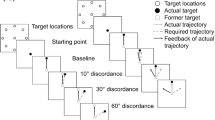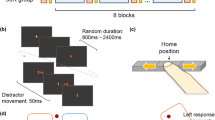Abstract
Two key features of sensorimotor adaptation are the directional selectivity of adaptive changes and the interference of adaptations to opposite directions. The present study investigated whether directional selectivity and interference of adaptation are related to executive functions and whether these phenomena differ between two methods for visuomotor adaptation. Subjects adapted at three target directions to clockwise or counterclockwise rotated feedback or to clockwise or counterclockwise target displacements (double steps). Both adaptation methods induce rotations of movement trajectories into the same direction, but provide visual information differently. The results showed that adaptation progressed differently between three targets. When movements adapted clockwise, adaptation was best at the most clockwise located target, and when movements adapted counterclockwise, it was best at the most counterclockwise located target, suggesting that spatial generalization between target directions is related to the direction of motor adaptation. The two adaptation methods produced different adaptation patterns, which indicate a further impact of visual information. A second adaptation to the other and opposite-directed discordance was worse than naive adaptation and washed out the aftereffects from the first adaptation, confirming that both adaptation methods interfered. Executive functions were significant covariate for overall interference and interference of target-specific adaptation. The results suggest that directional selectivity of adaptation is shaped by the direction of motor adaptation and the visual information provided. The interference of both adaptation methods indicates that they share adaptive mechanisms for recalibration. The interference is the lower the better subjects are able to cognitively switch between tasks and to inhibit prepotent responses. Therefore, cognitive functions seem to be involved in the inhibition of non-adequate sensorimotor responses.




Similar content being viewed by others
Notes
Data of a 26th subject had not been saved due to a computer error.
References
Abeele S, Bock O (2001) Sensorimotor adaptation to rotated visual input: different mechanisms for small versus large rotations. Exp Brain Res 140:407–410
Allen MD, Owens TE, Fong AK, Richards DR (2011) A functional neuroimaging analysis of the Trail Making Test-B: implications for clinical application. Behav Neurol 24:159–171
Anderson V, Jacobs R, Anderson PJ (2008) Executive functions and the frontal lobes: a lifespan perspective (studies on neuropsychology, neurology, and cognition). Taylor & Francis Group, New York
Anguera JA, Bernard JA, Jaeggi SM, Buschkuehl M, Brenson BL, Jennett S, Humfleet J, Reuter-Lorenz PA, Jonides J, Seidler RA (2012) The effects of working memory resource depletion and training on sensorimotor adaptation. Behav Brain Res 228:107–115
Baeumler G (1985) Farbe-Wort-Interferenztest (FWIT) nach J.R. Stroop. Hogrefe, Göttingen
Bédard P, Song JH (2013) Attention modulates generalization of visuomotor adaptation. J Vis 13(12):12
Bedford FL (1993) Perceptual and cognitive spatial learning. J Exp Psychol Hum 19:517–530
Bock O (2013) Basic principles of sensorimotor adaptation to different distortions with different effectors and movement types: a review and synthesis of behavioral findings. Front Hum Neurosci 7(81):1–5
Bock O, Girgenrath M (2006) Relationship between sensorimotor adaptation and cognitive functions in younger and older subjects. Exp Brain Res 169(3):400–406
Bock O, Schmitz G (2011) Adaptation to rotated visual feedback depends on the number and spread of target locations. Exp Brain Res 209(2):409–413
Bock O, Worringham C, Thomas M (2005) Concurrent adaptations of left and right arms to opposite visual distortions. Exp Brain Res 162:513–519
Bock O, Schmitz G, Grigorova V (2008) Transfer of adaptation between ocular saccades and arm movements. Hum Mov Sci 27:383–395
Borisova S, Bock O, Grigorova V (2014) Concurrent directional adaptation of reactive saccades and hand movements to target displacements of different size. J Motor Behav 46(5):303–308
Bortz J (2005) Statistik fuer Human- und Sozialwissenschafter. Springer Medizin Verlag, Heidelberg
Chase C, Seidler R (2008) Degree of handedness affects intermanual transfer of skill learning. Exp Brain Res 190:317–328
Cunningham HA, Welch RB (1994) Multiple concurrent visual-motor mappings: implications for models of adaptation. J Exp Psychol Hum 20(5):987–999
Eversheim U, Bock O (2001) Evidence for processing stages in skill acquisition: a dual-task study. Learn Mem 8:183–189
Girgenrath M, Bock O, Seitz RJ (2008) An fMRI study of brain activation in a visual adaptation task: activation limited to sensory guidance. Exp Brain Res 184(4):561–569
Grigorova V, Bock O, Borisova S (2013) Concurrent adaptation of reactive saccades and hand pointing movements to equal and to opposite changes of target directions. Exp Brain Res 226:63–71
Guadagnoli E, Velicer WF (1988) Relation of sample size to the stability of component patterns. Psych Bull 103:265–275
Heuer H, Hegele M (2008) Adaptation to visuomotor rotations in younger and older adults. Psychol Aging 23(1):190–202
Heuer H, Hegele M (2011) Generalization of implicit and explicit adjustments to visuomotor rotations across the workspace in younger and older adults. J Neurophysiol 106(4):2078–2085
Imamizu H, Kawato M (2008) Neural correlates of predictive and postdictive switching mechanisms for internal models. J Neurosci 28(42):10751–10765
Imamizu H, Uno Y, Kawato M (1995) Internal representations of the motor apparatus: Implications from generalization in visuomotor learning. J Exp Psychol Hum 21(5):1174–1198
Imamizu H, Sugimoto N, Osu R, Tsutsui K, Sugiyama K, Wada Y et al (2007) Explicit contextual information selectively contributes to predictive switching of internal models. Exp Brain Res 181(3):395–408
Kirsch P, Lis S, Esslinger C, Gruppe H, Danos P, Broll J, Wiltink J, Gallhofer B (2006) Brain Activation during mental maze solving. Neuropsychobiology 54:51–58
Krakauer JW, Pine ZM, Ghilardi MF, Ghez C (2000) Learning of visuomotor transformations for vectorial planning of reaching trajectories. J Neurosci 20(23):8916–8924
Lee GP, Strauss E, Loring DW, McCloskey L, Haworth JM, Lehman RAW (1997) Clin Neuropsychol 11(1):59–68
Lex H, Weigelt M, Knoblauch A, Schack T (2014) The functional role of cognitive frameworks on visuomotor adaptation performance. J Motor Behav 46(6):389–396
McLaughlin SC (1967) Parametic adjustment in saccadic eye movements. Percept Psychophys 2:359–362
McNay EC, Willingham DB (1998) Deficit in learning of a motor skill requiring strategy, but not of perceptualmotor recalibration, with aging. Learn Mem 4:411–420
Moosbrugger H, Oehlschlägel J, Steinwascher M (2011) Frankfurter-Aufmerksamkeitsinventar 2. Huber, Bern
Novick I, Vadia E (2011) Just do it: action dependent learning allows sensory prediction. PLoS ONE 6(10):e26020
Oswald WD, Roth E (1987) Der Zahlen-Verbindungs-Test [Number-Connection-Test]: Ein sprachfreier Intelligenztest zur Messung der „kognitiven Leistungsgeschwindigkeit. Hogrefe, Goettingen
Polk TA, Drake RM, Jonides JJ, Smith MR, Smith EE (2008) Attention enhances the neural processing of relevant features and suppresses the processing of irrelevant features in humans: a functional magnetic resonance imaging study of the stroop task. J Neurosci 28(51):13786–13792
Redding GM, Wallace B (1996) Adaptive spatial alignment and strategic perceptual-motor control. J Exp Psychol Human 22(2):379–394
Redding GM, Wallace (2011) Prism adaptation in left-handers. Atten Percept Psychophys 73:1871–1885
Regard M, Strauss E, Knapp P (1982) Childrens’ production on verbal and nonverbal fluency tasks. Percept Mot Skills 55(3):839–844
Reitan RM (1958) Validity of the Trail Making test as an indicator of organic brain damage. Percept Mot Skills 8:271–276
Roby-Brami A, Burnod Y (1995) Learning a new visuomotor transformation: error correction and generalization. Cogn Brain Res 2(4):229–242
Sainburg RL (2005) Handedness: differential specializations for control of trajectory and position. Exerc Sport Sci Rev 33(4):206–213
Schmitz G (2014) Visuo- und audiomotorische Adaptation. Hofmann-Verlag, Schorndorf. ISBN 978-3-7780-4850-4
Schmitz G, Bock O, Grigorova V, Ilieva M (2010) Adaptation of eye and hand movements to target displacements of different size. Exp Brain Res 203:479–484
Schmitz G, Bock O, Grigorova V, Borisova S (2012) Adaptation of hand movements to double-step targets and to distorted visual feedback: evidence for shared mechanisms. Hum Mov Sci 31:791–800
Seidler R, Bo J, Anguera JA (2012) Neurocognitive contributions to motor skill learning: the role of working memory. J Mot Behav 44(6):445–453
Shadmehr R, Wise SP (2005) The computational neurobiology of reaching and pointing: a foundation for motor learning Computational neuroscience. MIT-Press, Cambridge
Simon A, Bock O (2015) Does visuomotor adaptation proceed in stages? An examination of the learning model by Chein and Schneider. J Motor Behav 47(6):503–508
Smith EE, Jonides J (1999) Storage and executive processes in the frontal lobes. Science 283(5408):1657–1661
Spreen O, Strauss E (1998) A compendium of neuropsychological tests. Administration, norms, and commentary. Oxford University Press, New York
Tucha L, Aschenbrenner S, Koerts J, Lange KW (2012) The Five-Point Test: reliability, validity and normative data for children and adults. PLoS ONE 7(9):e46080. doi:10.1371/journal.pone.0046080
Wang J, Sainburg RL (2005) Adaptation to visuomotor rotations remaps movement vectors, not final positions. J Neurosci 25(16):4024–4030
Wang J, Sainburg RL (2006) Interlimb transfer of visuomotor rotations depends on handedness. Exp Brain Res 175:223–230
Welch RB (1978) Perceptual modification. Adapting to altered sensory environments. Academic Press, New York
Acknowledgments
Thanks to the staff of the project ‘Cognition in motion’ (Leibniz University Hannover, 60460288) for programming the software and their support during the cognitive testing.
Author information
Authors and Affiliations
Corresponding author
Ethics declarations
Ethical approval
All procedures performed were in accordance with the ethical standards of the institutional research committee and with the 1964 Helsinki Declaration and its later amendments. This article does not contain any studies with animals performed by the author.
Informed consent
Informed consent was obtained from all individual participants included in the study.
Conflict of interest
The author declares that he has no conflict of interest.
Rights and permissions
About this article
Cite this article
Schmitz, G. Interference between adaptation to double steps and adaptation to rotated feedback in spite of differences in directional selectivity. Exp Brain Res 234, 1491–1504 (2016). https://doi.org/10.1007/s00221-016-4559-y
Received:
Accepted:
Published:
Issue Date:
DOI: https://doi.org/10.1007/s00221-016-4559-y




